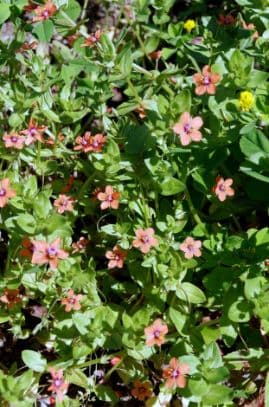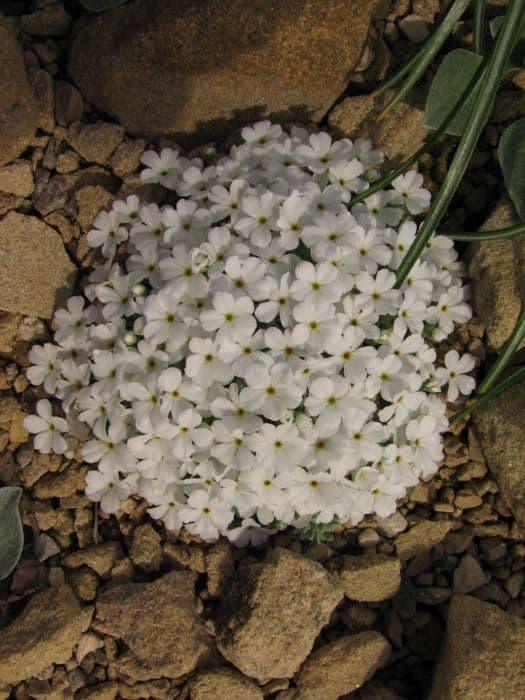Bear's Ear Auricula Primula auricula 'Winifrid' (Au/a)

ABOUT
The Primula auricula, commonly known as Auricula, is an ornamental plant known for its striking and unique appearance. 'Winifrid' is a cultivar that offers gardeners an attractive blend of colors and patterns. This particular cultivar boasts lush, velvety leaves that are typically a rich, deep green, forming a low-growing rosette. The flowers of 'Winifrid' are especially notable for their beauty. The petals display a range of hues, with colors that can vary from deep purples to warm yellows, often with a contrasting or complementary center or eye that adds depth and interest to the bloom. These colors may be accented with a pastel or sometimes powdery finish that gives the flowers an almost antique appearance. The petals themselves are rounded with a slight notch at the tips, which gives each flower a distinct, ornate look. Flowers are generally arranged in clusters that rise up on sturdy, upright stems, standing proudly above the foliage. The arrangement of the flowers provides a visual feast, making 'Winifrid' a popular choice for plant enthusiasts looking for vibrant color and a touch of elegance. In bloom, the Auricula 'Winifrid' is a showcase of ornate beauty, with each individual flower contributing to a magnificent display that can catch the eye from a distance. The color combination, petal shape, and overall presentation of this plant make it a prized specimen in any garden setting.
About this plant
 Names
NamesFamily
Primulaceae
Synonyms
Bear's Ear, Mountain Cowslip
Common names
Primula auricula 'Winifrid'.
 Toxicity
ToxicityTo humans
Auricula is not known to be highly toxic to humans. However, ingestion of this plant may cause mild gastrointestinal symptoms, such as nausea, vomiting, or diarrhea. Some individuals may also experience contact dermatitis when handling the plant due to the presence of primin - a compound found in the foliage.
To pets
Auricula is similarly not known to be highly toxic to pets. However, if pets ingest this plant, they could potentially experience mild gastrointestinal upset, which could manifest as vomiting or diarrhea. Just as in humans, some animals may also experience mild skin irritation or contact dermatitis if they come into contact with the plant's sap or foliage. It is always best to consult with a veterinarian if there are any concerns regarding a pet that has ingested part of the plant.
 Characteristics
CharacteristicsLife cycle
Perennials
Foliage type
Evergreen
Color of leaves
Green
Flower color
Varies
Height
6 inches (15 cm)
Spread
6 inches (15 cm)
Plant type
Herb
Hardiness zones
5
Native area
Europe
Benefits
 General Benefits
General Benefits- Ornamental Value: The Primula auricula 'Winifrid' is prized for its unique and vibrant flowers, adding a splash of color to gardens and landscapes.
- Low Maintenance: This variety of Primula is generally easy to care for, requiring minimal upkeep once established in the right conditions.
- Compact Size: It stays relatively small, making it suitable for rock gardens, container gardening, or borders without taking up too much space.
- Cold Hardiness: The Au/a can withstand cooler temperatures, making it suitable for planting in a variety of climates and extending its blooming season in spring.
- Attracts Pollinators: Its flowers can attract bees, butterflies, and other beneficial insects, aiding in the pollination of nearby plants.
 Medical Properties
Medical PropertiesThis plant is not used for medical purposes.
 Air-purifying Qualities
Air-purifying QualitiesThis plant is not specifically known for air purifying qualities.
 Other Uses
Other Uses- The leaves of the Primula auricula, also known as Bear's Ear, can be used to create natural dyes for fabrics, yielding colors ranging from green to yellow, depending on the mordant used.
- The petals of the Bear's Ear can be crystallized and used as edible decorations on cakes or desserts for an unusual and delicate touch to pastry arts.
- The plant has been historically used to add fragrance to potpourris, providing a fresh and pleasant scent to homemade mixtures.
- Bear's Ear can be utilized in the art of pressed flower crafts, where the flowers, due to their distinct shapes and colors, create attractive designs for bookmarks, cards, or framed artwork.
- As a natural indicator of soil quality, gardeners may use the presence and health of Bear's Ear as a sign of well-drained, chalky soils in their gardens.
- The vibrant flowers can serve as a visual aid in educational settings, demonstrating the concept of radial symmetry and Fibonacci sequences in botany classes.
- In floral language or floriography, Bear's Ear can be gifted as a symbol of uniqueness or specialty, given its rare and ornate appearance.
- The flower can inspire artwork, being a popular subject for watercolor artists due to its rich colors and intricate patterns, bringing a botanical theme to life.
- Bear's Ear, with its compact growth habit, may be used in fairy gardens or miniature landscapes, providing a touch of realism and color variety.
- Cultivation of this plant can be used in conservation education, as it embodies principles of breeding rare and heritage plant varieties, demonstrating biodiversity importance.
Interesting Facts
 Feng Shui
Feng ShuiThe Primula is not used in Feng Shui practice.
 Zodiac Sign Compitability
Zodiac Sign CompitabilityThe Primula is not used in astrology practice.
 Plant Symbolism
Plant Symbolism- Admiration: The auricula, being unique and vibrant, is often associated with admiration for its intricate beauty and distinct pattern.
- Patience: Auriculas take time to grow and bloom, symbolizing patience as one waits for the beautiful flowers to emerge.
- Perseverance: Tough and resilient to cold temperatures, the auricula represents the ability to endure and push through challenging conditions.
- Uniqueness: With its diverse color palette and patterns, the auricula stands for uniqueness, encouraging appreciation of individuality.
- Daintiness: The small and delicate flowers of the auricula suggest a sense of daintiness and fine detail.
- Hope: Often one of the first flowers to bloom in spring, the auricula can symbolize hope and the promise of new beginnings.
 Water
WaterAuriculas like 'Winifrid' should be watered carefully to avoid soaking the foliage or the crown of the plant, as this can lead to rot. It is best to water from below or to water at the base of the plant, allowing the soil to absorb moisture without wetting the leaves. The amount of water required can vary based on climate and soil conditions, but typically, during the active growing season, they may need about one gallon of water per week, depending on the weather and soil drainage. During the winter, watering should be reduced significantly, and the soil should be allowed to dry out between waterings to prevent root rot.
 Light
LightAuricula 'Winifrid' prefers bright, indirect light or partial shade. Direct sunlight can be too intense and may cause the leaves to scorch, especially in hotter climates. A north-facing windowsill or a spot that receives dappled sunlight under a tree canopy is ideal for providing these plants with the light conditions they thrive in.
 Temperature
TemperatureAuricula 'Winifrid' does best in cooler conditions and can tolerate temperatures down to about 20 degrees Fahrenheit for short periods. The ideal temperature range for vigorous growth is between 50 and 60 degrees Fahrenheit. However, they can survive up to approximately 80 degrees Fahrenheit, but at the higher end of this range, they may begin to show signs of stress such as wilting or yellowing leaves.
 Pruning
PruningAuriculas like 'Winifrid' benefit from deadheading spent flowers to encourage new blooms and maintain a tidy appearance. Remove dead or yellowing leaves to help prevent disease. Pruning is best done after the main flowering period, which is usually in late spring or early summer, depending on the local climate.
 Cleaning
CleaningAs needed
 Soil
SoilThe Bear's ear thrives in well-draining, fertile soil with added leaf mold or compost. The ideal soil mix should consist of one part garden loam, one part leaf mold or peat, and one part grit or perlite to ensure good drainage. The soil pH should be slightly acidic to neutral, ranging from 6.0 to 7.0.
 Repotting
RepottingBear's ear should be repotted every one to two years to replenish the soil and accommodate root growth. It's best to repot these plants after flowering, typically in the late spring or early summer.
 Humidity & Misting
Humidity & MistingBear's ear prefers moderate to high humidity levels, but it can tolerate lower humidity if not subjected to extreme conditions. Aim for humidity levels around 50-60% for optimal growth.
 Suitable locations
Suitable locationsIndoor
Place Bear's ear in bright, indirect light with moist soil.
Outdoor
Plant Bear's ear in dappled shade with well-draining soil.
Hardiness zone
4-8 USDA
 Life cycle
Life cyclePrimula auricula, commonly known as 'Winifrid', begins its life cycle when its seeds germinate in moist, well-draining soil during the late winter to early spring. After germination, seedlings emerge and develop a rosette of leaves, preparing to enter the vegetative growth stage where they develop their full foliage. Once mature, typically in their second year, they enter the flowering stage in late spring, displaying bright and colorful blossoms that attract pollinators. After pollination, the flowers produce seed capsules that mature by late summer, dispersing seeds to propagate for the upcoming generation. During the late fall and winter, 'Winifrid' enters a period of dormancy, reducing metabolic activity to survive cold temperatures. With the return of favorable conditions in spring, the cycle repeats as the plant emerges from dormancy to resume growth and restart the life cycle.
 Propogation
PropogationPropogation time
Spring-Early Summer
Propogation: The most popular method of propagating the Primula auricula, commonly known as Auricula or Bear's Ear, is through division, which is ideally done immediately after the plant finishes flowering in late spring or early summer. To propagate by division, carefully lift the plant from the ground and gently divide the clump into smaller sections, making sure each section has a good amount of roots. These segments can then be immediately replanted into well-draining soil at the same level they were previously growing. Water the newly planted divisions lightly to settle the soil around the roots and keep the soil moist but not waterlogged as the plants establish. Division helps to rejuvenate old clusters and stimulate vigorous growth, allowing gardeners to expand their Auricula collections or share with fellow enthusiasts.









